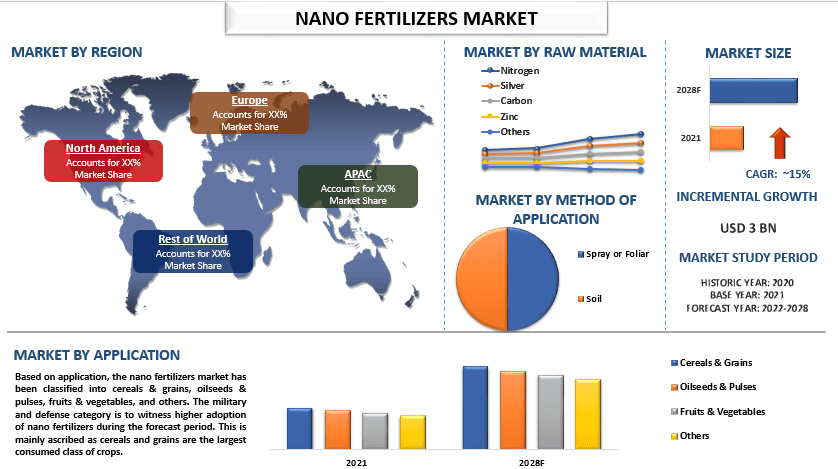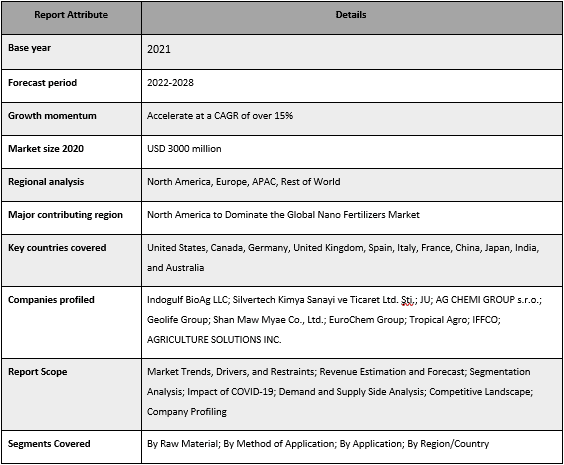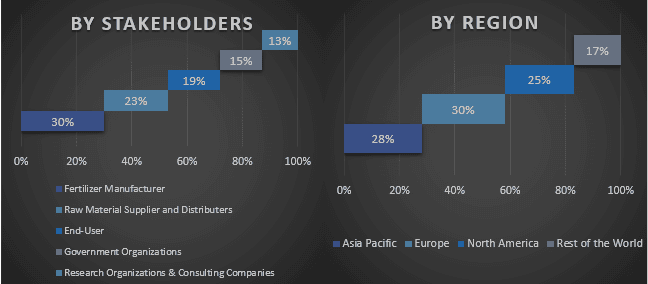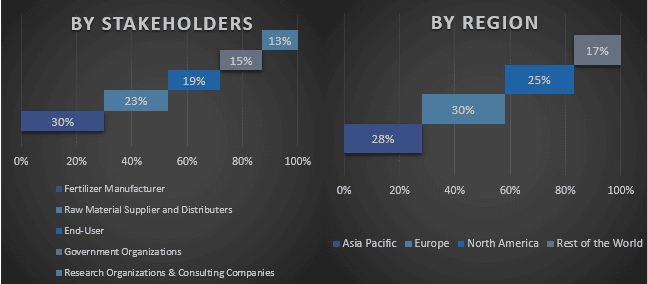
The nano fertilizers market is expected to grow at a strong CAGR of around 15% during the forecast period. Nano fertilizers refer to a new class of plant nutrients that are engineered at the nanoscale level. They are designed to enhance nutrient uptake by plants, reduce nutrient loss due to leaching, and improve soil health. The global market for nano fertilizers is expected to experience significant growth in the coming years, driven by several factors such as the increasing global population & the consequent rise in demand for food and agricultural products are expected to drive the demand for high-quality fertilizers. Also, the need for sustainable agriculture practices that minimize the environmental impact of chemical fertilizers is also driving the demand for nano fertilizers. Additionally, the development of advanced technologies for the manufacture of nano fertilizers is expected to drive down production costs, making them more affordable and accessible to farmers. For instance, Indian Farmers Fertilizer Cooperative Limited (IFFCO), produced over 87.02 lakh metric tons of fertilizer in 2021-2022. Therefore, it is anticipated that the market for nano fertilizers will expand steadily in the coming years, driven mostly by rising demand from developing nations.
Some of the major players operating in the market include Indogulf BioAg LLC; Silvertech Kimya Sanayi ve Ticaret Ltd. Şti.; JU; AG CHEMI GROUP s.r.o.; Geolife Group; Shan Maw Myae Co., Ltd.; EuroChem Group; Tropical Agro; IFFCO; AGRICULTURE SOLUTIONS INC. Several M&As along with partnerships have been undertaken by these players to facilitate customers with hi-tech and innovative products/technologies.
Insights Presented in the Report
“Amongst raw materials, the nitrogen category is to witness the fastest growth in this market in 2021.”
Based on raw material, the market is segmented into nitrogen, silver, carbon, zinc, and others. Amongst these, the nitrogen-based category is to witness the fastest growth in this market in 2021. This is because nitrogen-based fertilizers are still an affordable option. Also, fertilizer is still readily available to farmers and gives a variety of crops good nutrition. Furthermore, soil nitrogen frequently has a good impact on pasture and crop growth. As a result, it plays a crucial role in the development and reproduction of plants.
“Amongst application, the cereals & grains category held the majority share of the market in 2021.”
By application, the market is bifurcated into cereals & grains, oilseeds & pulses, fruits & vegetables, and others. Among these, the cereals & grains category captured the majority share of the nano fertilizers market in 2021. This is due to the rising demand for grains and cereals, particularly maize, wheat, and rice, is to blame for this. The FAO estimates that 2021 saw an increase in cereal production from 2777.7 million tonnes in 2020 to 2815.1 million tonnes. Farmers are switching to employing nano fertilizers as a result to satisfy this growing demand for production. For food growers around the world, their ability to increase crop output and efficiency in delivering crucial nutrients remains an attractive prospect.
Nano Fertilizers Market Report Coverage

“APAC Anticipated to Grow at The Fastest CAGR in 2021.”
APAC is anticipated to grow at the fastest CAGR during the forecast period. This is mainly due to the large population in the region and the high demand for nutritional food. Moreover, rising agricultural yields is one of the major factors in the countries like China, India, and Australia. Furthermore, rising investment and government subsidies in the agriculture sector will boost the demand for fertilizers in the region. For instance, the Indian Government increased subsidy allocation for fertilizers from USD 9.83 million to more than USD 11 million in 2019. These factors are also contributing to the growth of the water-soluble fertilizers market.
Reasons to buy this report:
Customization Options:
The global Nano Fertilizers Market can further be customized as per the requirement or any other market segment. Besides this, UMI understands that you may have your own business needs, hence feel free to connect with us to get a report that completely suits your requirements.
1. Market Introduction
2. Research Methodology Or Assumption
3. Market Synopsis
4. Executive Summary
5. Impact Of Covid-19 On The Nano Fertilizers Market
6. Nano Fertilizers Market Revenue, 2020-2028f
7. Market Insights By Raw Material
8. Market Insights By Method Of Application
9. Market Insights By Application
10. Market Insights By Region
11. Nano Fertilizers Market Dynamics
12. Nano Fertilizers Market Opportunities
13. Nano Fertilizers Market Trends
14. Demand And Supply-side Analysis
15. Value Chain Analysis
16. Pricing Analysis
17. Strategic Insights
18. Competitive Scenario
19. Company Profiled
20. Disclaimer
Research Methodology for the Nano Fertilizers Market Analysis (2022-2028)
Analyzing the historical market, estimating the current market, and forecasting the future market of the global Nano Fertilizers Market were the three major steps undertaken to create and analyze the adoption of smart homes in major regions globally. Exhaustive secondary research was conducted to collect the historical market numbers and estimate the current market size. Secondly, to validate these insights, numerous findings and assumptions were taken into consideration. Moreover, exhaustive primary interviews were also conducted, with industry experts across the value chain of the global Nano Fertilizers Market. Post assumption and validation of market numbers through primary interviews, we employed a top-down/bottom-up approach to forecasting the complete market size. Thereafter, market breakdown and data triangulation methods were adopted to estimate and analyze the market size of segments and sub-segments of the industry pertains to. Detailed methodology is explained below:
Analysis of Historical Market Size
Step 1: In-Depth Study of Secondary Sources:
Detail secondary study was conducted to obtain the historical market size of the Nano Fertilizers Market through company internal sources such as annual reports & financial statements, performance presentations, press releases, etc., and external sources including journals, news & articles, government publications, competitor publications, sector reports, third-party database, and other credible publications.
Step 2: Market Segmentation:
After obtaining the historical market size of the Nano Fertilizers Market, we conducted a detailed secondary analysis to gather historical market insights and share for different segments & sub-segments for major regions. Major segments are included in the report as raw material, method of application, and application. Further country-level analyses were conducted to evaluate the overall adoption of testing models in that region.
Step 3: Factor Analysis:
After acquiring the historical market size of different segments and sub-segments, we conducted a detailed factor analysis to estimate the current market size of the Nano Fertilizers Market. Further, we conducted factor analysis using dependent and independent variables such as raw material, method of application, and application of the nano fertilizers market. A thorough analysis was conducted for demand and supply-side scenarios considering top partnerships, mergers and acquisitions, business expansion, and product launches in the Nano Fertilizers Market sector across the globe.
Current Market Size Estimate & Forecast
Current Market Sizing: Based on actionable insights from the above 3 steps, we arrived at the current market size, key players in the global Nano Fertilizers Market, and market shares of the segments. All the required percentage shares split, and market breakdowns were determined using the above-mentioned secondary approach and were verified through primary interviews.
Estimation & Forecasting: For market estimation and forecast, weights were assigned to different factors including drivers & trends, restraints, and opportunities available for the stakeholders. After analyzing these factors, relevant forecasting techniques i.e., the top-down/bottom-up approach were applied to arrive at the market forecast for 2028 for different segments and sub-segments across the major markets globally. The research methodology adopted to estimate the market size encompasses:
Market Size and Share Validation
Primary Research: In-depth interviews were conducted with the Key Opinion Leaders (KOLs) including Top Level Executives (CXO/VPs, Sales Head, Marketing Head, Operational Head, Regional Head, Country Head, etc.) across major regions. Primary research findings were then summarized, and statistical analysis was performed to prove the stated hypothesis. Inputs from primary research were consolidated with secondary findings, hence turning information into actionable insights.
Split of Primary Participants in Different Regions

Market Engineering
The data triangulation technique was employed to complete the overall market estimation and to arrive at precise statistical numbers for each segment and sub-segment of the global Nano Fertilizers Market. data was split into several segments & sub-segments post studying various parameters and trends in the areas of the raw material, method of application, and application in the global Nano Fertilizers Market.
The main objective of the Global Nano Fertilizers Market Study
The current & future market trends of the global Nano Fertilizers Market were pinpointed in the study. Investors can gain strategic insights to base their discretion for investments on the qualitative and quantitative analysis performed in the study. Current and future market trends determined the overall attractiveness of the market at a regional level, providing a platform for the industrial participant to exploit the untapped market to benefit from a first-mover advantage. Other quantitative goals of the studies include:

Customers who bought this item also bought